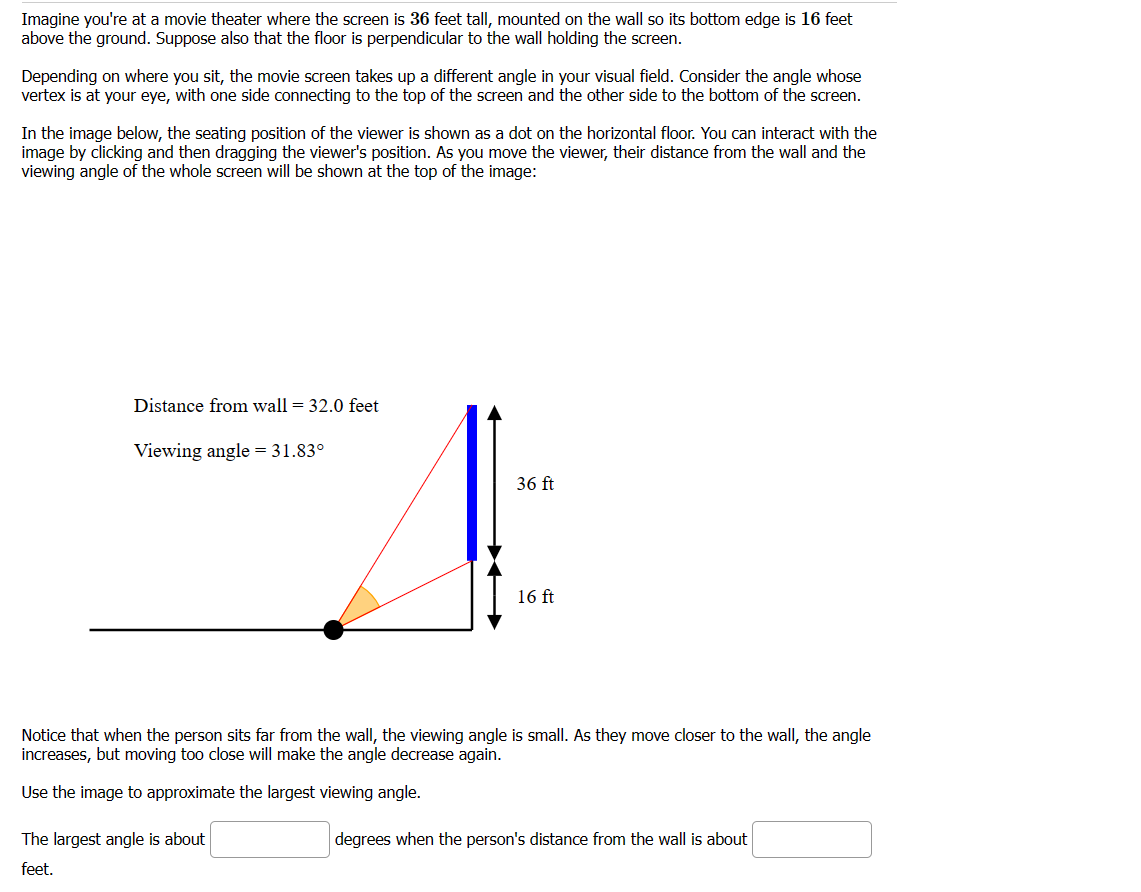Imagine you're at a movie theater where the screen is 36 feet tall, mounted on the wall so its bottom edge is 16 feet above the ground. Suppose also that the floor is perpendicular to the wall holding the screen. Depending on where you sit, the movie screen takes up a different angle in your visual field. Consider the angle whose vertex is at your eye, with one side connecting to the top of the screen and the other side to the bottom of the screen. In the image below, the seating position of the viewer is shown as a dot on the horizontal floor. You can interact with the image by clicking and then dragging the viewer's position. As you move the viewer, their distance from the wall and the viewing angle of the whole screen will be shown at the top of the image: Distance from wall = 32.0 feet Viewing angle = 31.83° 36 ft 16 ft Notice that when the person sits far from the wall, the viewing angle is small. As they move closer to the wall, the angle increases, but moving too close will make the angle decrease again. Use the image to approximate the largest viewing angle. The largest angle is about degrees when the person's distance from the wall is about feet.
Imagine you're at a movie theater where the screen is 36 feet tall, mounted on the wall so its bottom edge is 16 feet above the ground. Suppose also that the floor is perpendicular to the wall holding the screen. Depending on where you sit, the movie screen takes up a different angle in your visual field. Consider the angle whose vertex is at your eye, with one side connecting to the top of the screen and the other side to the bottom of the screen. In the image below, the seating position of the viewer is shown as a dot on the horizontal floor. You can interact with the image by clicking and then dragging the viewer's position. As you move the viewer, their distance from the wall and the viewing angle of the whole screen will be shown at the top of the image: Distance from wall = 32.0 feet Viewing angle = 31.83° 36 ft 16 ft Notice that when the person sits far from the wall, the viewing angle is small. As they move closer to the wall, the angle increases, but moving too close will make the angle decrease again. Use the image to approximate the largest viewing angle. The largest angle is about degrees when the person's distance from the wall is about feet.
Elementary Geometry For College Students, 7e
7th Edition
ISBN:9781337614085
Author:Alexander, Daniel C.; Koeberlein, Geralyn M.
Publisher:Alexander, Daniel C.; Koeberlein, Geralyn M.
Chapter5: Similar Triangles
Section5.3: Proving Triangles Similar
Problem 41E: Prove that the altitude drawn to the hypotenuse of a right triangle separates the right triangle...
Related questions
Question

Transcribed Image Text:Imagine you're at a movie theater where the screen is 36 feet tall, mounted on the wall so its bottom edge is 16 feet
above the ground. Suppose also that the floor is perpendicular to the wall holding the screen.
Depending on where you sit, the movie screen takes up a different angle in your visual field. Consider the angle whose
vertex is at your eye, with one side connecting to the top of the screen and the other side to the bottom of the screen.
In the image below, the seating position of the viewer is shown as a dot on the horizontal floor. You can interact with the
image by clicking and then dragging the viewer's position. As you move the viewer, their distance from the wall and the
viewing angle of the whole screen will be shown at the top of the image:
Distance from wall = 32.0 feet
Viewing angle -31.83°
36 ft
16 ft
Notice that when the person sits far from the wall, the viewing angle is small. As they move closer to the wall, the angle
increases, but moving too close will make the angle decrease again.
Use the image to approximate the largest viewing angle.
The largest angle is about
degrees when the person's distance from the wall is about
feet.
Expert Solution
This question has been solved!
Explore an expertly crafted, step-by-step solution for a thorough understanding of key concepts.
This is a popular solution!
Trending now
This is a popular solution!
Step by step
Solved in 7 steps with 21 images

Recommended textbooks for you

Elementary Geometry For College Students, 7e
Geometry
ISBN:
9781337614085
Author:
Alexander, Daniel C.; Koeberlein, Geralyn M.
Publisher:
Cengage,

Trigonometry (MindTap Course List)
Trigonometry
ISBN:
9781337278461
Author:
Ron Larson
Publisher:
Cengage Learning

Elementary Geometry for College Students
Geometry
ISBN:
9781285195698
Author:
Daniel C. Alexander, Geralyn M. Koeberlein
Publisher:
Cengage Learning

Elementary Geometry For College Students, 7e
Geometry
ISBN:
9781337614085
Author:
Alexander, Daniel C.; Koeberlein, Geralyn M.
Publisher:
Cengage,

Trigonometry (MindTap Course List)
Trigonometry
ISBN:
9781337278461
Author:
Ron Larson
Publisher:
Cengage Learning

Elementary Geometry for College Students
Geometry
ISBN:
9781285195698
Author:
Daniel C. Alexander, Geralyn M. Koeberlein
Publisher:
Cengage Learning

Linear Algebra: A Modern Introduction
Algebra
ISBN:
9781285463247
Author:
David Poole
Publisher:
Cengage Learning

Mathematics For Machine Technology
Advanced Math
ISBN:
9781337798310
Author:
Peterson, John.
Publisher:
Cengage Learning,

Algebra & Trigonometry with Analytic Geometry
Algebra
ISBN:
9781133382119
Author:
Swokowski
Publisher:
Cengage